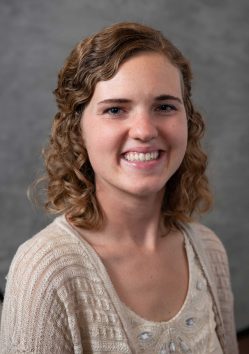
The Changing Varieties in an Apple Orchard
05 December 2019Elizabeth Wittenbach, 25-year-old fifth-generation farmer, predicts future consumers’ taste for the crunchy, juicy, sweet apple.
By Lisa Parrish, GMC Editor
 Drag out your Magic 8 Ball and answer this question: What fruit texture, flavor and color will be popular with consumers in the year 2026? Now, are you willing to bet part of your farm on the answer? Those are the questions apple farmer Elizabeth Wittenbach is answering this month on the Wittenbach Orchards farm in Belding, Mich.
Drag out your Magic 8 Ball and answer this question: What fruit texture, flavor and color will be popular with consumers in the year 2026? Now, are you willing to bet part of your farm on the answer? Those are the questions apple farmer Elizabeth Wittenbach is answering this month on the Wittenbach Orchards farm in Belding, Mich.
Foreseeing trends in the apple market is something Elizabeth has been taught by her father Mike and grandfather Ed before that. At 25 years old, Elizabeth is a fifth-generation farmer.
“I’m predicting what consumers want to buy in 10 years. I’ve got to pay attention to the market,” she said.
It’s not quite like being a fortune teller, but Elizabeth and Mike are creating their 2022 new apple tree order throughout November and December 2019. The wait begins once rootstock trees have been ordered. Apple trees are delivered to the farm more than a year after they were ordered. When they arrive, they will be a minimum of a year old and have bloomed once. The trees are then planted on the farm and it will be another three or more years before a full apple harvest is collected.
“It’s the million-dollar question right now,” Elizabeth said about the new tree ordering process.
Wittenbach Orchards produces apples for the fresh consumption market as opposed to the processed apple market. The 220-acre farm grows MacIntosh, Sweet Tango, Gala, Honey Crisp and Fuji varieties. Elizabeth estimated they grow more than six million pounds of apples a season. (Click here to watch a video illustrating the Wittenbach’s farming practices. https://youtu.be/DW9ekynJgVo)
 The farm has vastly changed since her great great grandfather immigrated from Switzerland and bought a dairy business with a small orchard in 1899. She credits her grandfather with making the switch from cattle to fruit. “He didn’t want to work every day and that was necessary with cows,” she explained. He sold the cattle and started planting apple trees. Back then, apple trees were planted in a 40-foot by 40-foot area with a peach tree placed between the apple trees. And, each apple tree was allowed to grow tall. It wasn’t unusual for a tree to take up to 10 years to produce a decent crop, according to Elizabeth.
The farm has vastly changed since her great great grandfather immigrated from Switzerland and bought a dairy business with a small orchard in 1899. She credits her grandfather with making the switch from cattle to fruit. “He didn’t want to work every day and that was necessary with cows,” she explained. He sold the cattle and started planting apple trees. Back then, apple trees were planted in a 40-foot by 40-foot area with a peach tree placed between the apple trees. And, each apple tree was allowed to grow tall. It wasn’t unusual for a tree to take up to 10 years to produce a decent crop, according to Elizabeth.
“There were big challenges with the move to high density planting and smaller trees,” Elizabeth noted. Today, trees are planted in a 12-foot by three-foot plot and trees will usually produce a small apple crop for two to three years, with full production requiring up to seven years.
The spring season will see the Wittenbach’s planting their newly arrived saplings while replacing older trees. It’s also when Elizabeth will walk her orchard looking for pests such as fruit-boring or tree-boring moths or fruit-eating stink bugs. “I look for diseases and pests to time our control measures,” she said.
 Spring is also pollination time and Elizabeth works with a local beekeeper who cares for the approximately 100 hives scattered around the orchard.
Spring is also pollination time and Elizabeth works with a local beekeeper who cares for the approximately 100 hives scattered around the orchard.
Managing a tree’s crop load, the number of apples produced, is important. Throughout the late spring, a chemical thinner is sprayed on the trees that will reduce the number of fruitlets, or the small apples that appear after the blooming process. Thinning the tree’s crop will maximize the remaining apples’ size, quality and color.
“It’s a pretty stressful time,” Elizabeth said. “You can accidentally knock off a whole crop.”
During the summer months, Elizabeth works on the mature orchard pruning trees to allow for more light (which affects an apple’s color) and tending to the younger trees securing them to trellises. The trees are irrigated with drip lines that keep them correctly hydrated to ensure the apples grow to the correct size.
When harvest begins in August it’s an all-hands-on-deck time, Elizabeth said. Forty people are required to harvest apples for approximately three months. “It’s all done by hand,” Elizabeth said. “The industry is moving toward robotics but it’s not there yet.” Workers no longer climb ladders but are moved to the top of tress on platforms. The Wittenbach’s have planted a variety of apples that ripen on a rolling basis throughout the three-month harvest.
“We do a starch test in the field to determine maturity,” Elizabeth explained. As an apple grows, the inherent starch turns to sugar. The test features an iodine solution placed on a freshly-cut apple. The starch will turn black and Elizabeth and her coworkers can determine ripeness from the amount of black covering the apple.
Picking the apple at the correct ripeness is important because if it’s too green it will not be perfect when it arrives at the market for fresh consumption. If it’s too mature, the fruit will not tolerate time in storage. “It’s important to get the timing right,” she said.
There are some apples that require extra care during harvesting. “Some varieties have soft skin and when picked the crew members have to cut off the stems. This slows down the crew but it’s important to maintain quality,” Elizabeth noted.
Fall is the time of year Elizabeth enjoys consuming her favorite apple product – apples fresh off the tree. “I eat quite a bit of apples in the fall,” she said. Her most loved variety is Sweet Tango. “It’s the perfect mix of sweet and tart. It’s juicy and has crunch. It just has all the right things, if you ask me.”
Although Red Delicious apples have long been a consumer favorite, they don’t hold much in the way of taste for Elizabeth. “To me, the skin is so thick and it doesn’t have that crisp crunch when you bite into it.” Apparently, Elizabeth is mirroring consumers’ palates because for the first time in 50 years, Gala became the most produced apple variety in the United States this year.
Mark Seetin, US Apple director of regulatory and industry affairs, said, “The rise in production of newer varieties of apples aimed at the fresh consumption domestic market has caused demand for Red Delicious to decline.”
Elizabeth understands the increased varietal choice and consumers’ changing tastes. She and her family have been watching the trends for years. “I think we’ve positioned ourselves well for the next decade,” she said. “It sure keeps it interesting.”
Last May, Elizabeth took over the US Apple Instagram account and recorded several short videos that illustrate her orchard duties in the spring. Click here to watch:
https://www.instagram.com/p/BxxiGeYFrVF/
https://www.instagram.com/p/BxxDOWNlTeP/
https://www.instagram.com/p/Bxxrl0SldML/
https://www.instagram.com/p/BxyP1QuFbW8/
https://www.instagram.com/p/BxyX_d8lEn4/
